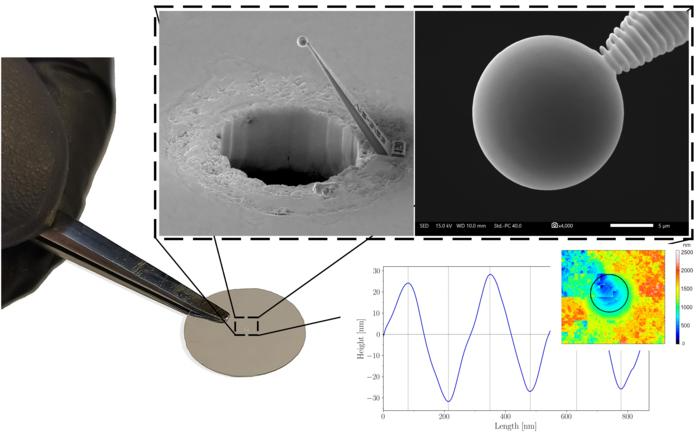Researchers from the Institute of Electronic Structure and Laser—Foundation for Research and Technology-Hellas, the University of Helsinki, and Ruhr University Bochum have devised a novel method for producing superior microspheres through laser-based 3D printing, as documented in a recent study published in Light: Advanced Manufacturing.
 The 3D micro-device consists of a modified coverslip and a micro-sphere fabricated by advanced MPL. It can enhance the lateral resolution beyond what is achievable with conventional optics. Image Credit: Gordon Zyla, Göran Maconi, Anton Nolvi, Jan Marx, Dimitra Ladika, Ari Salmi, Vasileia Melissinaki, Ivan Kassamakov, and Maria Farsari
The 3D micro-device consists of a modified coverslip and a micro-sphere fabricated by advanced MPL. It can enhance the lateral resolution beyond what is achievable with conventional optics. Image Credit: Gordon Zyla, Göran Maconi, Anton Nolvi, Jan Marx, Dimitra Ladika, Ari Salmi, Vasileia Melissinaki, Ivan Kassamakov, and Maria Farsari
Currently, optical microscopy is one of the most used techniques across numerous interdisciplinary domains for small-scale object, organism, or surface inspection. However, the diffraction of light places a basic restriction on its lateral resolution, which has grown more crucial with the application of conventional lenses as the need for higher resolutions has increased.
Micro-sphere-assisted microscopy is a field of study that integrates a dielectric micro-sphere behind the final imaging lens of an optical microscope. This integration offers a viable way to boost lateral resolution considerably. Nevertheless, there are significant practical restrictions associated with the usage of dielectric microspheres that are sold commercially.
Proper handling of the micro-spheres necessitates laborious procedures, and the sizes of dielectric micro-spheres that are commercially accessible are constrained. These difficulties prevent micro-sphere-assisted microscopy from being widely used as an affordable substitute for expensive microscopy techniques like atomic force or scanning electron microscopy.
Using multi-photon lithography (MPL), this method produces real three-dimensional structures at the micro- and nanoscale without needing a mask. Furthermore, MPL’s nonlinear nature allows for significant improvements in accuracy through localized laser intensity refinement throughout the printing process.
The researchers achieved a remarkable result by combining this intricate method with a cutting-edge hatching and slicing strategy to create a 20 µm-diameter microsphere with outstanding surface smoothness and nearly flawless geometric quality (λ/8).
Ultimately, the microsphere was printed on a coverslip with a hole in the middle created by femtosecond laser ablation. The combination of this modified coverslip and the micro-sphere forms a 3D micro-device, allowing for flexible manipulation of the sphere and potential incorporation into any optical microscope.
The micro-sphere’s performance in the 3D micro-device was assessed using a Mirau-type coherence scanning interferometer (MCSI) and a calibration grid with a resolving power of λ = 0.28. As a consequence, the sphere's optical qualities outperformed the normal resolution limits of conventional lenses in visible light while maintaining MSCI’s high axial resolution.
The 3D micro-device, which was fabricated in about eight minutes, including the modification of the coverslip and the fabrication of the sphere, clearly demonstrates its practicality as a real-world solution. Furthermore, MPL’s unique capabilities enable the development of novel micro-optical structures and systems to improve lateral resolution in both 2D and 3D optical microscopy.
Looking forward, the scientists emphasize the multiple applications for MPL in this sector, underlining its great potential for producing custom-designed components that increase resolution in any optical microscope.
Journal Reference:
Zyla, G., et. al. (2024) 3D micro-devices for enhancing the lateral resolution in optical microscopy. Light: Advanced Manufacturing. doi:10.37188/lam.2024.019